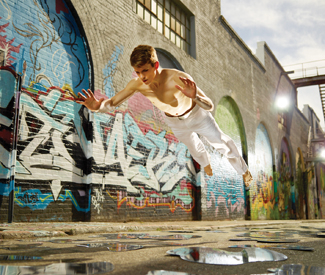arts@sfbg.com
DANCE Ben Levy sure knows how to throw a party. For the 10th anniversary celebration of his LEVYdance company, he once again closed off SOMA alley Heron Street, where his studio is located, and hung balloons, speakers, and lights. He put up bars and set out soft sofas, and erected a large stage with a central pit full of pillows (for those who might prefer to recline). It was one of those rare San Francisco evenings with clear skies — and just the slightest of breezes — which made you glad you don’t live across any bridges.
But does Levy know to choreograph? You bet he does. A decade ago he burst onto the San Francisco dance scene with clarity of vision and skills to match, unheard-of in a dancer just barely out of college. But that’s exactly why this festive event lacked an essential ingredient.
Seeing the four works — one from 2002, two from 2004, and one from 2005 — put a damper on the evening. No amount of finessing and rethinking of repertoire can take the place of the risk and excitement involved when a choreographer steps into unknown territory. Looking back on a decade’s accomplishments may be gratifying, but more essential is giving an audience an inkling of where the artistic trajectory is going.
Grant Diffendaffer’s open-air stage, essentially an elevated square of walkways around an open center, necessitated some reconfigurations that diluted what sometimes felt like volcanic forces about to explode in Levy’s choreography. But it also allowed for increased intimacy, depending on where you sat.
Levy’s four dancers dove into the choreography with an impressive unity of purpose. They attacked complex interactions — often at top speed — with razor sharp timing. Seeing the dancers dressed in brilliant white against the riotous chaos of the graffiti covered brick walls suggested an unexpected symbiotic relationship between dance and murals.
pOrtal, the oldest piece on the program, still fascinated in the way Scott Marlowe, Yu Kondo Reigen, Paul Vickers, and Sarah Dianne Woods upset each other’s balances. They grabbed, yanked, and poked; flipped a partner; or pushed a knee against a belly. When a dancer leaned over a colleague’s knee, it would drop away beneath them. The idea seems to be avoiding stability at any cost — like living in the middle of a non-stop earthquake. What might look like violence or aggression in another case is delivered in such a matter-of-fact way that it becomes a self-contained image of one way of being.
Originally, If this small space, choreographed by Levy and Rachael Lincoln, was performed on a five-by-five lit square that set up limitations. Shifted to the open, the attention immediately shifted onto the internal forces that strained against the confines of Marlowe’s body. Performed magnificently by this beautiful dancer, If this small space might have him look up and push against invisible walls — but it was the small trembles, muscular contractions, currents, and mysterious somethings rolling through his torso that collapsed his knees. The effect indicated just how at the mercy of imprisoning forces this human being was. Perhaps the most touching moment came when Marlowe lifted one leg and it looked like it might try to float away from him.
The engaging Holding Pattern opened with Reigen’s stunningly performed solo, in which warring forces seemed to tear her body apart as Vickers and Woods traced a cautious circle around her. The trio engaged in a contentious give and take, part wrestling match, part karate engagement. For a while it looked like the two women were ganging up on Vickers, but then he gave as good as he got.
That Four Letter Word (apply your own definition) finds the quartet in every possible permutation of relationships between two men and two women. Some of it is quite funny — though I could have done without the balloon jokes — but here the spatial reconfigurations created too much distance. Four ran out of steam though it did showcase Vickers and Marlowe — super-articulate, elegant dancers — exquisitely mirroring each other.
The program also highlighted Levy’s excellent musical choices — many of them commissioned. Let’s hope he’ll soon have an opportunity to use some more.

